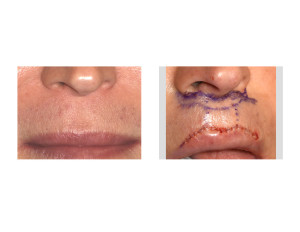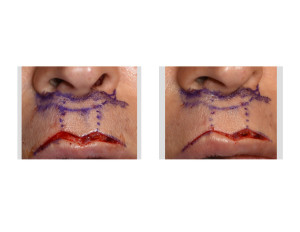Augmentation of the upper lip is one of the most commonly done non-surgical facial enhancement procedures. This can usually be successfully done through the use of a variety of different hyaluronic acid-based injectable fillers. Despite their popularity and frequency of use, however, injectable fillers can not solve all aesthetic upper lip concerns. A thin upper lip with little vermilion height often does not respond well to volume addition alone and is prone to result in the dreaded ‘duck lip’ look where most of the filler volume comes horizontally forward rather than increasing vertical vermilion height.
Surgical lip augmentation offers a better result in the thin upper lip because it can alter the location of the vermilion-cutaneous junction…the one anatomic feature by which lip size and shape is mainly judged. This can be done by an ‘upper’ lip procedure known as a subnasal lip lift or a ‘lower’ upper lip procedure known as a vermilion advancement. While very close by location the effects of these two surgical lip procedures can be dramatically different.
One way that they differ is in the effects on the cupid’s bow area. An aesthetically important feature of the upper lip, the cupid’s bow or tubercle, is a double curve of the lip which resembles a bow laid on its side. The peaks of the bow coincide with the vertical philtral columns coming down from the nose giving a prominent bow appearance to the upper lip. While a subnasal lip lift will pull up on the central cupid’s bow area it will really reshape or ‘sharpen up‘ its shape. Only a vermilion advancement can create that change since it changes it directly by skin excision.

While cupid’s bow augmentation does create a fine line scar at the new vermilion-cutaneous junction it typically heals very well as it is not under undue tension due to the limited resection area.
Dr. Barry Eppley
Indianapolis, Indiana



